- US futures, European stocks resume Tuesday’s cyclical rotation
- FTSE 100 and GBP advance as Prime Minister Johnson strives for Brexit deal
Key Events
Global shares as well as futures on the Dow, S&P and Russell 2000 advanced on Wednesday as renewed talks on US fiscal stimulus and hopes that a Brexit deal is back on track}} allowed investors turn a blind eye to the relentless spread of the coronavirus.
Future contracts on the NASDAQ were down as the on-again, off-again cyclical rotation, which led all major averages to new all-time highs, is expected to continue. As of the time of writing, it appears the tech sector will remain to be under pressure.
Key Financial Events
Global stocks received a boost after the Trump administration unexpectedly renewed virus relief package talks, with a $916 billion offer. As time runs out before President-elect Joseph Biden takes over on Jan. 20, investors are betting on an imminent deal and that regulators will approve Pfizer's (NYSE:PFE) vaccine for emergency use authorization as early as Thursday.
A face-off between buyers and sellers resulted in futures for the NASDAQ edging lower, demonstrating that sellers are willing to compromise on their asking price to unload contracts.

Perhaps the NQ will retest the uptrend line, in place since Nov. 2.
In Europe, the Stoxx 600 broke free of the range in which it was trapped since November, to reach its highest level since Feb. 26 amid the ongoing cyclical rotation between pandemic-driven sectors, such as tech, to stocks sensitive to economic recovery, such as banking and energy, which are benefiting from COVID-19 vaccine tailwinds.
This morning, the UK's FTSE 100 jumped to its highest level since early March, even against the backdrop of a strengthening pound. Recently, the index benefited from the weaker pound, which helped boost the country’s exports. As Prime Minister Boris Johnson heads to Brussels for dinner with European Commission President Ursula von der Leyen, traders are hoping that a Brexit deal both sides can stomach is on the menu.
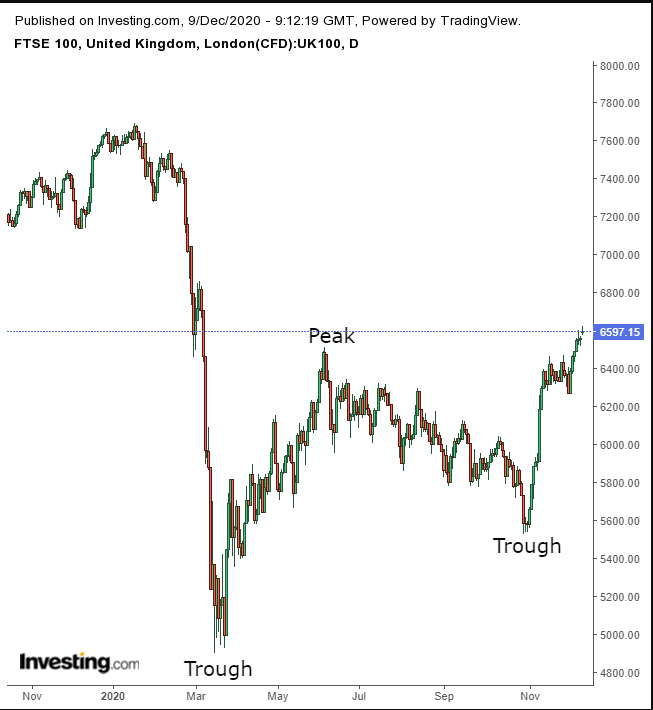
The FTSE 100 registered its second highest peak, completing a medium-term uptrend, despite coronavirus woes and the potentially far worse possibility of a no-deal Brexit.
Earlier today, most Asian stocks rose. Japan’s Nikkei reached its highest level since 1990, while South Korea's KOSPI took home a double-record, hitting both a closing and intraday high.
China’s Shanghai Composite bucked the global uptrend and closed down 1.1%, after the country's consumer price index dropped in November for the first time in a decade, due to falling food prices.
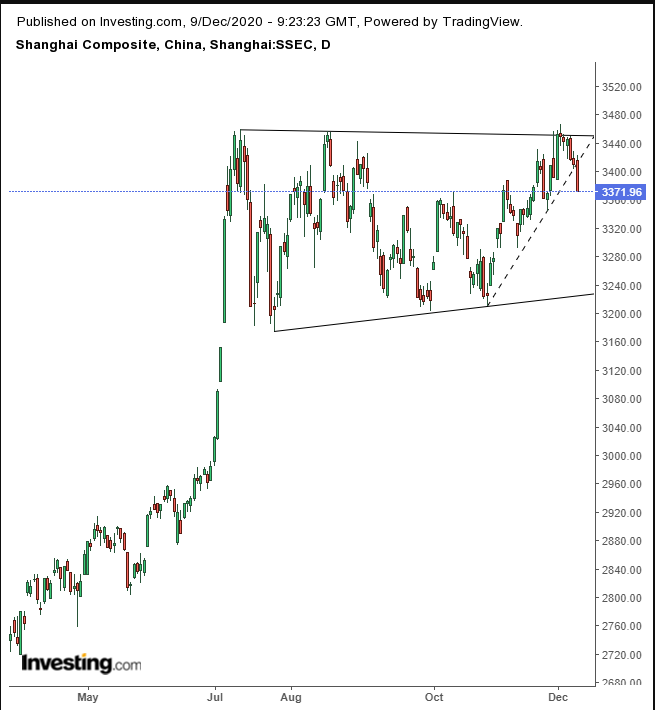
The selloff increases the odds the benchmark's return toward the 3,240 level, the bottom of a range since the July highs. Any deeper downturn would confirm a top.
US stocks carved out new highs on Tuesday as a focus on negotiations over a fiscal aid package improved sentiment.
The S&P 500 notched both an all-time high and a record close. The Dow Jones snuck in a new intraday high but failed to lock in those gains at the close.
The NASDAQ Composite and NASDAQ 100 each registered a double whammy—both hit all-time highs and record closes. Still, the NASDAQ 100 underperformed after a ten straight-day gain. The Russell 2000 also landed in the record books—hitting it highest closing level ever.
Yields, including on the 10-year note, rose, snapping a two-day decline, on the view of continued depressed rates.
Revised stimulus hopes, which would pump the economy full of cheap cash, lowered the value of the dollar. Also, an ongoing foreign Treasury liquidation includes a USD sell.
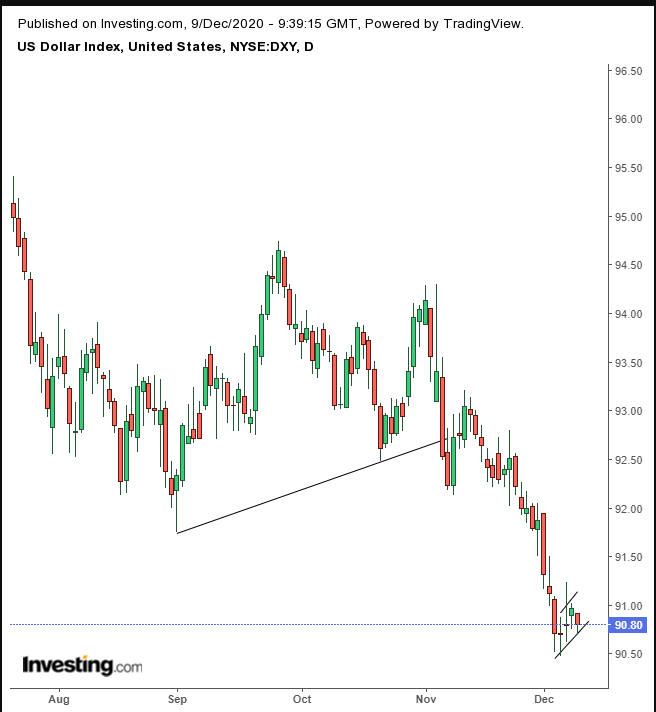
The greenback fell within what could become a dollar short squeeze—a period during which traders cover shorts thereby boosting the currency—the end of which will likely resume the sharp downturn that followed a continuation H&S pattern.
The greenback found its footing after falling against the yuan to its lowest since mid-2018.
Gold fell despite a weakening dollar as traders sought to increase risk.

Technically, the yellow metal found resistance by the 50 DMA, protecting the top of a falling channel.
Bitcoin fell for the third day, blowing out a bullish pennant.
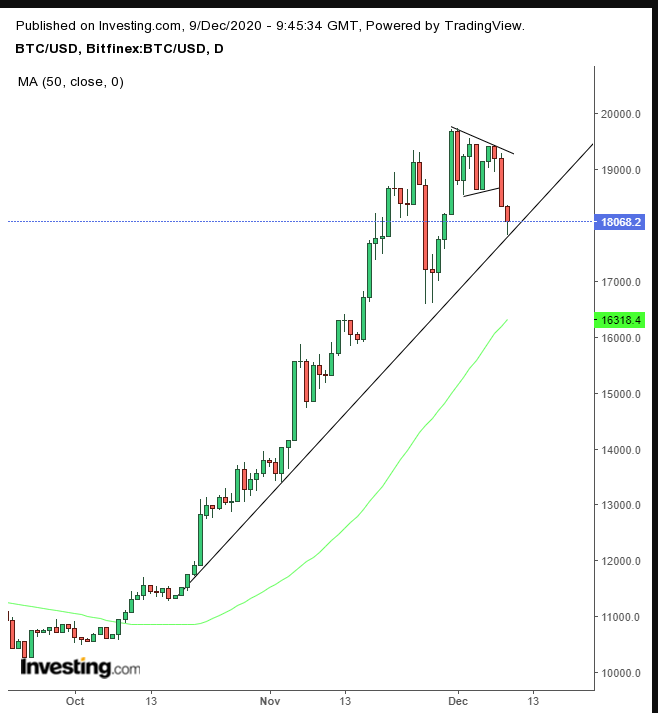
We expect the cryptocurrency to be propelled higher. Currently, it is testing its uptrend line.
Oil {{art-200546414||bounced off the top of a bullish flag
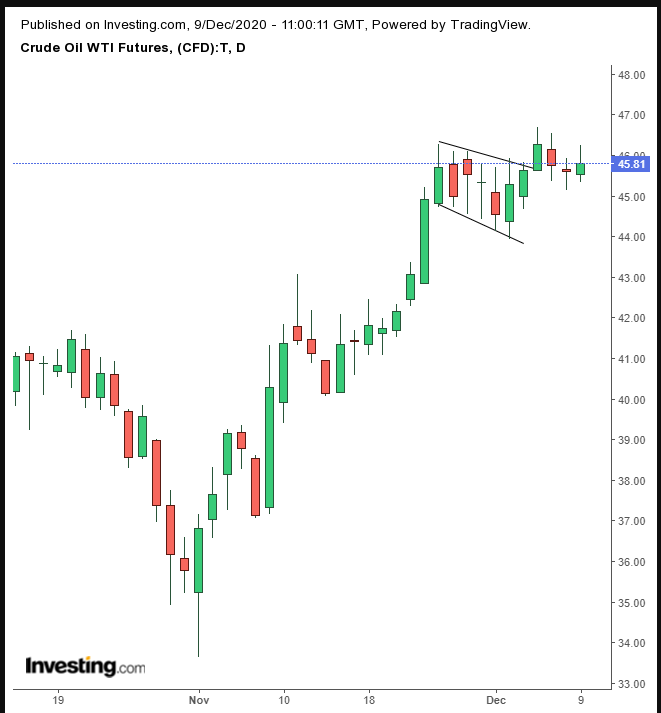
Up Ahead
- Official crude oil inventories are released later today.
- The Bank of Canada will announce its interest rate decision after the market opens in Toronto on Wednesday.
- Thursday brings the European Central Bank policy decision and a press briefing from Christine Lagarde. Economists widely expect the central bank to increase and extend its pandemic bond-buying program.
- The US Food and Drug Administration meets to discuss the vaccine made by Pfizer/Biontech on Thursday. If the FDA authorizes emergency use, distribution could begin within 24 hours.
Market Moves
Stocks
- The Stoxx Europe 600 Index increased 0.6%.
- NASDAQ 100 Index futures were little changed.
- Futures on the S&P 500 Index climbed 0.2%.
- The MSCI Asia Pacific Index gained 0.7%.
Currencies
- The Dollar Index dipped 0.2% to 90.77.
- The British pound gained 0.4% to $1.3415.
- The Japanese yen weakened 0.1% to 104.24 per dollar.
- The Taiwanese dollar was little changed at NT$28.51 per U.S. dollar.
Bonds
- The yield on 10-year Treasuries increased two basis points to 0.94%.
- Britain’s 10-year yield gained two basis points to 0.278%.
- Germany’s 10-year yield gained one basis point to -0.60%.
- Japan’s 10-Year yield advanced less than one basis point to 0.022%.
